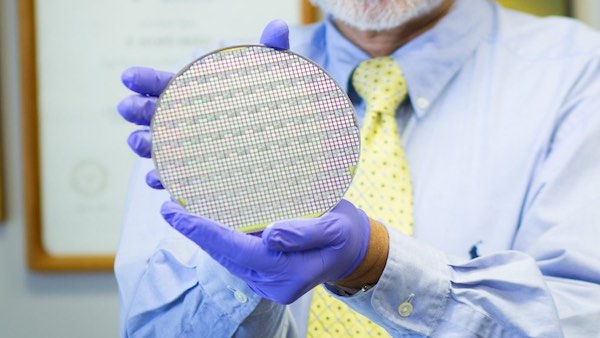
[Image above] Silicon carbide devices, like the one shown here, are more efficient than their silicon counterparts. Credit: North Carolina State University
Many materials have attempted to unseat silicon in its reigning position over the electronics world.
We’ve seen a lot of research on suitable substitutes, including 2-D materials, nickel alloys, magnetic multiferroics, and transition metal dischalcogenides.
And perhaps some of the most promising moves towards silicon’s spot have come from gallium nitride.
Another material is also a strong contender because it has some fantastic properties—silicon carbide’s wide bandgap make it ideal for power electronics.
That wide bandgap allows SiC power devices to run at lower temperatures and higher frequencies, which ultimately translates into a higher power density—SiC devices can pack more performance into a smaller package, allowing improved performance in our favorite electronics.
So why hasn’t silicon carbide taken over when it comes to power electronics? It all comes down to manufacturing.
For one, it’s incredibly difficult for any material to compete with silicon—the maturity and extensive scale of silicon electronics manufacturing means that the market is well established and prices are really low.
Developing silicon carbide manufacturing processes isn’t easy either, and the groups that have successfully done so have, not surprisingly, kept their practices proprietary. That sets the barriers prohibitively high to competitively enter into the silicon carbide power electronics market.
That might soon be about to change, however—North Carolina State University researchers have developed a SiC manufacturing process that may finally give this material the boost it needs to compete against silicon in the electronics market.
And this is no lab benchmark—the team has fully implemented and qualified the SiC manufacturing process, called PRESiCE, at a semiconductor foundry.
By working with X-Fab, a worldwide semiconductor foundry group with a U.S. location in Lubbock, Texas, the researchers have already demonstrated that PRESiCE can be used to manufacture SiC power devices, including MOSFETs, ACCUFETs, JBS rectifiers, and a power JBSFET.
Although the technical details behind the trademarked process are unknown, the team has qualified the manufacturing process, “showing that it has the high yield and tight statistical distribution of electrical properties for SiC power devices necessary to make them attractive to industry,” according to an NCSU press release.
The project was sponsored by the U.S. Department of Energy-backed PowerAmerica, an organization entirely devoted to advancing silicon carbide and gallium nitride electronic technologies.
The NCSU team’s goal is to streamline development of SiC manufacturing techniques, which can be a costly venture for manufacturers to develop. Instead of developing a proprietary SiC manufacturing process in house, manufacturers can instead license the already developed technology, which is also more efficient than existing SiC manufacturing techniques.
“PRESiCE will allow more companies to get into the SiC market, because they won’t have to initially develop their own design and manufacturing process for power devices—an expensive, time-consuming engineering effort,” Jay Baliga, Distinguished University Professor of Electrical and Computer Engineering at NC State and lead author of the research, says in the release. “The companies can instead use the PRESiCE technology to develop their own products. That’s good for the companies, good for consumers, and good for U.S. manufacturing.”
The team has already licensed PRESiCE to one company and is working on further expansions of the technology.
The idea is that getting more companies to manufacture SiC devices will ultimately further reduce costs by increasing volume. And that’s important because SiC devices currently cost about five times as much as those made of silicon, according to the release. The researchers want to drastically reduce that cost to further reduce the barriers for SiC devices.
“Our goal is to get it down to 1.5 times the cost of silicon devices,” Baliga says. “Hopefully that will begin the ‘virtuous cycle’: lower cost will lead to higher use; higher use leads to greater production volume; greater production volume further reduces cost, and so on. And consumers are getting a better, more energy-efficient product.”
The research, titled “PRESiCETM: PRocess Engineered for manufacturing SiC Electronic-devices”, was presented at the International Conference on Silicon Carbide and Related Materials in Washington, D.C., Septebmer 17–22.
Did you find this article interesting? Subscribe to the Ceramic Tech Today newsletter to continue to read more articles about the latest news in the ceramic and glass industry! Visit this link to get started.
Author
April Gocha
CTT Categories
- Electronics
- Manufacturing
- Material Innovations


